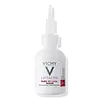What's inside
What's inside
 Key Ingredients
Key Ingredients

 Benefits
Benefits

 Concerns
Concerns

 Ingredients Side-by-side
Ingredients Side-by-side

Water
Skin ConditioningGlycerin
HumectantPentylene Glycol
Skin ConditioningIsononyl Isononanoate
EmollientAlcohol Denat.
AntimicrobialDicaprylyl Ether
EmollientGlycine Soja Oil
EmollientPropylene Glycol
HumectantPEG-6 Caprylic/Capric Glycerides
EmulsifyingHydrolyzed Rice Protein
Skin ConditioningHydroxyacetophenone
AntioxidantPalmitoyl Tetrapeptide-7
Skin ConditioningPalmitoyl Tripeptide-1
Skin ConditioningPentaerythrityl Tetra-Di-T-Butyl Hydroxyhydrocinnamate
AntioxidantSodium Hyaluronate
HumectantSodium Hydroxide
BufferingTrisodium Ethylenediamine Disuccinate
Vitreoscilla Ferment
Skin ConditioningRetinol
Skin ConditioningDicaprylyl Carbonate
EmollientAmmonium Polyacryloyldimethyl Taurate
Emulsion StabilisingButylene Glycol
HumectantCaprylyl Glycol
EmollientCarbomer
Emulsion StabilisingGlyceryl Isostearate
EmollientPolysorbate 20
EmulsifyingPPG-6-Decyltetradeceth-30
EmulsifyingSodium Lactate
BufferingTocopherol
AntioxidantXanthan Gum
EmulsifyingWater, Glycerin, Pentylene Glycol, Isononyl Isononanoate, Alcohol Denat., Dicaprylyl Ether, Glycine Soja Oil, Propylene Glycol, PEG-6 Caprylic/Capric Glycerides, Hydrolyzed Rice Protein, Hydroxyacetophenone, Palmitoyl Tetrapeptide-7, Palmitoyl Tripeptide-1, Pentaerythrityl Tetra-Di-T-Butyl Hydroxyhydrocinnamate, Sodium Hyaluronate, Sodium Hydroxide, Trisodium Ethylenediamine Disuccinate, Vitreoscilla Ferment, Retinol, Dicaprylyl Carbonate, Ammonium Polyacryloyldimethyl Taurate, Butylene Glycol, Caprylyl Glycol, Carbomer, Glyceryl Isostearate, Polysorbate 20, PPG-6-Decyltetradeceth-30, Sodium Lactate, Tocopherol, Xanthan Gum
Salicylic Acid 2%
MaskingWater
Skin ConditioningGlycerin
HumectantIsononyl Isononanoate
EmollientButylene Glycol
HumectantKaolin
AbrasiveZinc Sulfate
AntimicrobialBifida Ferment Lysate
Skin ConditioningSodium Hydroxide
BufferingSodium Polyacrylate
AbsorbentSodium Hyaluronate
HumectantSodium Benzoate
MaskingPhenoxyethanol
PreservativeAscorbyl Glucoside
AntioxidantHydrolyzed Algin
Trisodium Ethylenediamine Disuccinate
Biosaccharide Gum-1
HumectantAcrylates/C10-30 Alkyl Acrylate Crosspolymer
Emulsion StabilisingParfum
MaskingSalicylic Acid 2%, Water, Glycerin, Isononyl Isononanoate, Butylene Glycol, Kaolin, Zinc Sulfate, Bifida Ferment Lysate, Sodium Hydroxide, Sodium Polyacrylate, Sodium Hyaluronate, Sodium Benzoate, Phenoxyethanol, Ascorbyl Glucoside, Hydrolyzed Algin, Trisodium Ethylenediamine Disuccinate, Biosaccharide Gum-1, Acrylates/C10-30 Alkyl Acrylate Crosspolymer, Parfum
 Reviews
Reviews

Ingredients Explained
These ingredients are found in both products.
Ingredients higher up in an ingredient list are typically present in a larger amount.
Butylene Glycol (or BG) is used within cosmetic products for a few different reasons:
Overall, Butylene Glycol is a safe and well-rounded ingredient that works well with other ingredients.
Though this ingredient works well with most skin types, some people with sensitive skin may experience a reaction such as allergic rashes, closed comedones, or itchiness.
Learn more about Butylene GlycolGlycerin is already naturally found in your skin. It helps moisturize and protect your skin.
A study from 2016 found glycerin to be more effective as a humectant than AHAs and hyaluronic acid.
As a humectant, it helps the skin stay hydrated by pulling moisture to your skin. The low molecular weight of glycerin allows it to pull moisture into the deeper layers of your skin.
Hydrated skin improves your skin barrier; Your skin barrier helps protect against irritants and bacteria.
Glycerin has also been found to have antimicrobial and antiviral properties. Due to these properties, glycerin is often used in wound and burn treatments.
In cosmetics, glycerin is usually derived from plants such as soybean or palm. However, it can also be sourced from animals, such as tallow or animal fat.
This ingredient is organic, colorless, odorless, and non-toxic.
Glycerin is the name for this ingredient in American English. British English uses Glycerol/Glycerine.
Learn more about GlycerinIsononyl Isononanoate is a synthetic skin-conditioner and texture enhancer. It is created from nonanoic acid, a fatty acid found in cocoa and lavender oil.
As an emollient, Isononyl Isononanoate helps keep your skin soft and smooth. This is because emollients create a barrier on the skin to trap moisture in.
Isononyl Isononanoate helps give products a velvet feel and improves spreadability.
Learn more about Isononyl IsononanoateSodium Hyaluronate is hyaluronic acid's salt form. It is commonly derived from the sodium salt of hyaluronic acid.
Like hyaluronic acid, it is great at holding water and acts as a humectant. This makes it a great skin hydrating ingredient.
Sodium Hyaluronate is naturally occurring in our bodies and is mostly found in eye fluid and joints.
These are some other common types of Hyaluronic Acid:
Learn more about Sodium HyaluronateSodium Hydroxide is also known as lye or caustic soda. It is used to adjust the pH of products; many ingredients require a specific pH to be effective.
In small amounts, sodium hydroxide is considered safe to use. However, large amounts may cause chemical burns due to its high alkaline.
Your skin has a natural pH and acid mantle. This acid mantle helps prevent harmful bacteria from breaking through. The acid mantle also helps keep your skin hydrated.
"Alkaline" refers to a high pH level. A low pH level would be considered acidic.
Learn more about Sodium HydroxideTrisodium Ethylenediamine Disuccinate is used to help stabilize a product.
It is a chelating agent, meaning it helps prevent metal ions from binding to other ingredients. This prevents unwanted reactions in products. Metal ions can come into a product via the water ingredient. They are found in trace amounts and are not known to be harmful.
Water. It's the most common cosmetic ingredient of all. You'll usually see it at the top of ingredient lists, meaning that it makes up the largest part of the product.
So why is it so popular? Water most often acts as a solvent - this means that it helps dissolve other ingredients into the formulation.
You'll also recognize water as that liquid we all need to stay alive. If you see this, drink a glass of water. Stay hydrated!
Learn more about Water